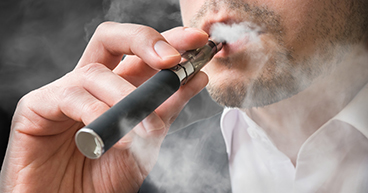
Many people believe the best way to kick a smoking habit is by transitioning to e-cigarettes. Though this idea has become popularized in recent years, e-cigarettes are not a safe alternative. Why? The danger lies in the heated ingredients that may include a mix of potentially harmful chemicals. Also, although e-cigarettes do not contain tobacco, many include nicotine, which comes from tobacco. Nicotine is a highly addictive chemical compound that can change the way the brain works and cause physical and psychological dependence.
In this article, we’ll explore several aspects of vaping and e-cigarettes, including:
- How e-cigarettes work
- Ingredients found in e-cigarettes
- The potential health risks of vaping
- E-cigarettes and young people
- Tips to quit smoking
If you’ve been diagnosed with cancer and have questions about cancer treatments offered at Cancer Treatment Centers of America® (CTCA), or if you’re interested in a second opinion on your cancer diagnosis and treatment regimen, call us or chat online with a member of our team.
How do e-cigarettes work?
The “e” in e-cigarettes stands for electronic. They are considered “heat-not-burn” devices and products. Regular cigarettes or cigars need to be ignited by a flame to burn tobacco to create the smoke that’s inhaled. E-cigarettes are battery operated. The battery powers an atomizer, an element inside the device that heats a liquid stored in a cartridge into an aerosol, or a vapor (hence the term vaping) that’s inhaled. The user may either push a button or just inhale to activate a vaping device.
E-cigarettes come in multiple sizes and shapes. Some are disposable, others rechargeable. One particular brand popular among young people sells a device small enough to fit in the palm of your hand and can be charged through the USB port on a laptop.
What ingredients are found in e-cigarettes?
Like some tobacco products, e-cigarettes come in a variety of styles and flavors that may appeal to specific genders and age groups. But almost all vapes contain nicotine and many have a long list of suspected carcinogens in the liquid—or e-juice—that circulate throughout the user’s body.
E-cigarette ingredients may include:
- Propylene glycol, found to increase lung and airway irritation after concentrated exposure
- Volatile organic compounds (VOCs), which cause eye, nose and throat irritation, headaches and nausea, and can damage the liver, kidney and nervous system
- Flavoring chemicals, which contain different levels of diacetyl a compound linked to the serious lung disease bronchiolitis obliterans
- Formaldehyde, which may form if e-liquid overheats, or not enough liquid reaches the heating element (known as a “dry-puff”)
Potential health risks of vaping
Compared to regular cigarettes and other tobacco products that have been around for centuries, e-cigarettes are a relatively new phenomenon. And while research continues into the health risks associated with vaping, enough is known for the U.S. Centers for Disease Control and Prevention (CDC) and the U.S. Food and Drug Administration (FDA) to caution Americans not to use these products.
Here’s some of what is known about health risks associated with vaping:
E-cigarettes may be highly addictive, especially among young people. Research indicates that adolescents and some young adults may be more easily addicted to e-cigarettes. And one study suggests that vaping may be harder to quit than smoking.
Vaping may cause inflammation and/or injuries. Ingredients in e-cigarettes are often heated to very high temperatures that, when inhaled, may cause irritation and inflammation of the mouth, throat, esophagus and lungs. According to the CDC, nearly 3,000 Americans have been hospitalized or have died from e-cigarette, or vaping, product use-associated lung injury (EVALI).
The American Cancer Society reports serious lung disease has developed in some e-cigarettes users, with symptoms including:
- Cough, trouble breathing or chest pain
- Nausea, vomiting or diarrhea
- Fatigue, fever or weight loss
Is there a link between e-cigarettes and cancer? The answer may not be known for decades. Researchers in Ireland say there is “clear reason for concern regarding the potential oncogenicity of e-cigarettes/e-liquids,” but the research may take at least 20 years to determine the link.
E-cigarettes and young people
Vaping health risks are still being evaluated and more research is required, but scientists are finding increasing proof the chemicals in the ingredients are dangerous and the consequences severe. Recent studies have shown people who vape have a 59 percent higher risk of a heart attack, 40 percent higher risk of heart disease and 71 percent higher risk of stroke than non-users.
According to a CDC study, in 2020, an estimated 3.6 million (13.1 percent) U.S. middle and high school students reported using e-cigarettes within the past 30 days and more than 80 percent of current users reported using flavored devices.
Vaping has become “cool” and popular among middle schoolers and high schoolers. The appeal stems from the glorification of cigarettes, with smoking often glamorized in the media and pop culture. According to the American Lung Association, 39 percent of young users vape because a "friend or family member" does, 31 percent because of "flavors such as mint, candy, fruit, or chocolate" and 17 percent have the belief "they are less harmful than other forms of tobacco such as cigarettes." This misinformation, targeted advertising and normalized activity are dangerous.
An October 2021 report in JAMA Pediatrics showed teen vaping of marijuana doubled between 2013 and 2020, signaling that young people may be replacing joints, pipes or bongs with vape pens, exacerbating the potential for adverse physical and cognitive health outcomes.
Bottom line: The use of e-cigarettes is unsafe for kids, teens and young adults. While experts do not know the full extent of negative health consequences wrought by e-cigarettes, they do understand the puff isn’t worth the price of someone’s health. Dedicated prevention and intervention resources must be directed at middle and high school students to help them stop using e-cigarettes in a safe manner and ideally never start. It’s on us—the village of parents and loved ones, teachers, health care providers, coaches and other influencers—to talk to children about the dangers of vaping.
Tips to quit smoking
Despite the well-documented and well-known dangers of smoking, an estimated 34.2 million Americans continue to smoke. Also well-documented: Quitting is hard. According to the FDA, 70 percent of smokers say they want to quit and 55 percent said they at least tried (most failed).
If you want to quit, don’t turn to vaping. Neither the CDC nor the FDA endorses e-cigarettes as part of a strategy to quit tobacco products.
Instead, consider these tips:
Talk to your doctor. Prescription drugs and other strategies are available to help you kick the habit.
Go to smokefree.gov. Download the app on your smartphone or go online to get offers, tips and information on quitting.
Change things up. If you smoked at certain times of the day, occupy your hands and your mouth with other activities at those times. Do a crossword puzzle or chew gum. Switching up your routine may help you break the habitual nature inherent in smoking.
Get support. It helps to receive encouragement from those close to you, especially if you’re in quarantine with others.
Try to relax. Turn to yoga. Listen to soothing music. Take deep breaths.
Stay hydrated. Many smokers trying to quit complain of dry mouth, so keep a glass or bottle of water handy, and take frequent sips throughout the day.
If you’ve been diagnosed with cancer and have questions about cancer treatments offered at CTCA®, or if you’re interested in a second opinion on your cancer diagnosis and treatment regimen, call us or chat online with a member of our team.


